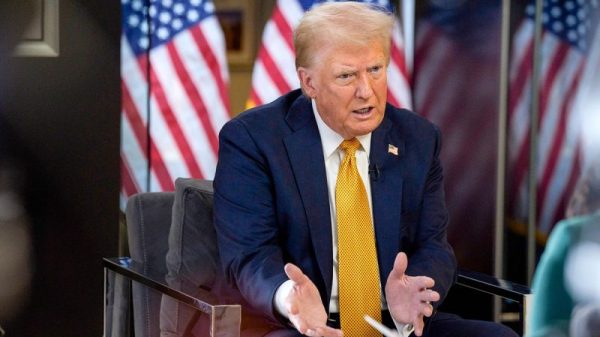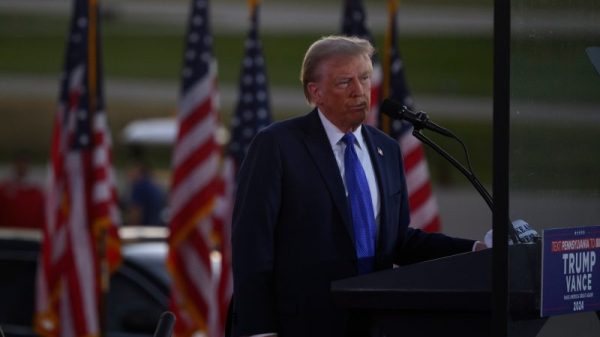There was a brief period on the night of Nov. 6, 2012, when it appeared to some people that President Barack Obama would win reelection to the White House despite losing the popular vote. This was largely because California hadn’t counted all its votes; Obama would end up not only passing Republican Mitt Romney but winning a majority of votes cast.
But one Republican who’d endorsed Romney was incensed at the idea.
“The electoral college is a disaster for a democracy,” Donald Trump wrote on social media, going on to demand that Americans “march on Washington and stop this travesty.” He would eventually delete the posts.
Four years later, of course, no one in these United States was more enthusiastic about the power of the electoral college than Trump. He lost the popular vote in 2016, taking the White House only because he won narrowly enough in three states — Wisconsin, Michigan and Pennsylvania — to prevail in the electoral college.
Four years after that, he tried to wrangle the electoral college to his advantage again, encouraging a march on Washington to stop the travesty of his Democratic opponent winning both the popular and electoral votes. It didn’t work.
That 2020 election also ended up hinging on three states, albeit different ones. Take away Joe Biden’s narrow wins in Georgia, Arizona and Wisconsin, and you take away his electoral college majority. In fact, you take away any electoral college victory. Flip those three states and the election ends in a 269-269 tie. And here you thought the aftermath of 2020 couldn’t be worse.
Looking forward to November, Trump on Tuesday endorsed a proposal that would avoid such a scenario this year. He praised Nebraska Gov. Jim Pillen’s (R) support for legislation that would change how his state distributes electoral votes. No longer would the winner of the state get two votes, with the other three going to the winner in each congressional district. Instead, all five electoral votes would go to the candidate that won overall — the Republican in every election since 1968.
“Most Nebraskans have wanted to go back to this system for a very long time, because it’s what 48 other States do,” Trump, now a fervent electoral college supporter, wrote on social media. “It’s what the Founders intended, and it’s right for Nebraska.”
In a statement, Pillen echoed that point: Such a change would “better reflect the founders’ intent.”
Well, not really. The process originally established by the Constitution looks nothing like our current process, assigning state legislatures the job of choosing electors who would vote for two people they thought would be an effective president. If one candidate got a majority of the vote, they became president, and the second-place finisher became vice president.
That wasn’t a great system, so in 1804, the 12th Amendment made some tweaks, including introducing a separate vote for the vice president. (You can read the whole story here.) But it was not the case that the electors were meant to reflect the will of voters in the state.
Over time, most states implemented systems in which the choosing of electors was tied to the popular vote in the state. In most places, that meant a winner-take-all system. In Nebraska and Maine, it meant divvying them up. Each state gets an elector for each senator and representative; Nebraska and Maine give the senators’ electors (two in total) to the statewide winner and the others to the winner in each House district.
The effect is that those two states can name electors for each major party’s candidate, but that hasn’t happened much. Nebraska offered up one elector for the Democratic candidate in 2008 and 2020; Maine had one for the Republican in 2016 and 2020. This was a more accurate reflection of the will of their states’ voters, certainly, but it did very little to affect the imbalance between the national popular- and electoral-vote margins.
It’s easy to forget how unbalanced those two measures often are. Below we present a century of presidential election results, with the national popular vote split shown in the outer ring and the resulting electoral vote distribution shown in the pie chart in the middle. Notice how the extent of the red and blue regions vary widely between the outer and inner rings.
We can look at this another way. The chart below shows the Republican popular vote share (horizontal) and electoral vote share (vertical) over the past century. The dotted line indicates a perfect match between popular vote and electoral vote. No year sits squarely on the line and the further from 50 percent the popular vote results get, the wider the deviation of the electoral vote proportion from that dotted line.
Changing Nebraska’s rules would not have affected the outcome in either of the contests where the state split its electors between major-party candidates. But if you’re Trump, you can see the advantage. Retake Arizona, Georgia and Wisconsin and force that one Nebraska congressional district to go along with the statewide vote and voilà! You’ve got a 270-268 electoral college victory.
But what if we went the other way, distributing electors nationally the way they are allocated in Nebraska and Maine?
The results are slightly surprising. Using DailyKos’s calculations of congressional district results from presidential contests, we see that, in 2016, Trump would still have earned a majority of electoral votes. The reason is simple: We’re still giving states two electors for each senator, meaning that the imbalance that exists in the Senate for less-populated red states is mirrored in the newly determined electoral college, too. But with the Nebraska model in place, the electoral vote split is at least a bit closer to the popular vote that year (Trump getting 54 percent of electors vs. the 57 percent he actually got).
In 2020, Biden would still emerge victorious, with his electoral vote total under the Nebraska plan landing almost exactly where his national popular vote percentage did. But it’s still Trump who sees the advantage. Biden’s four-point popular vote margin gives him a three-percentage-point electoral-college edge. Trump’s two-point loss in 2016 lands as an eight-percentage-point advantage under the Nebraska distribution method. Closer than his actual 14-percentage-point advantage in the electoral college but of little consolation for Hillary Clinton.
What Trump is endorsing in Nebraska is uncomplicated: a way for him to snatch up one more electoral vote. It would be interesting to see how Trump would respond if the governor of Maine issued precisely the same statement as Pillen; presumably, Trump would be less enthusiastic about how it reflected the purported will of the Founding Fathers.







































